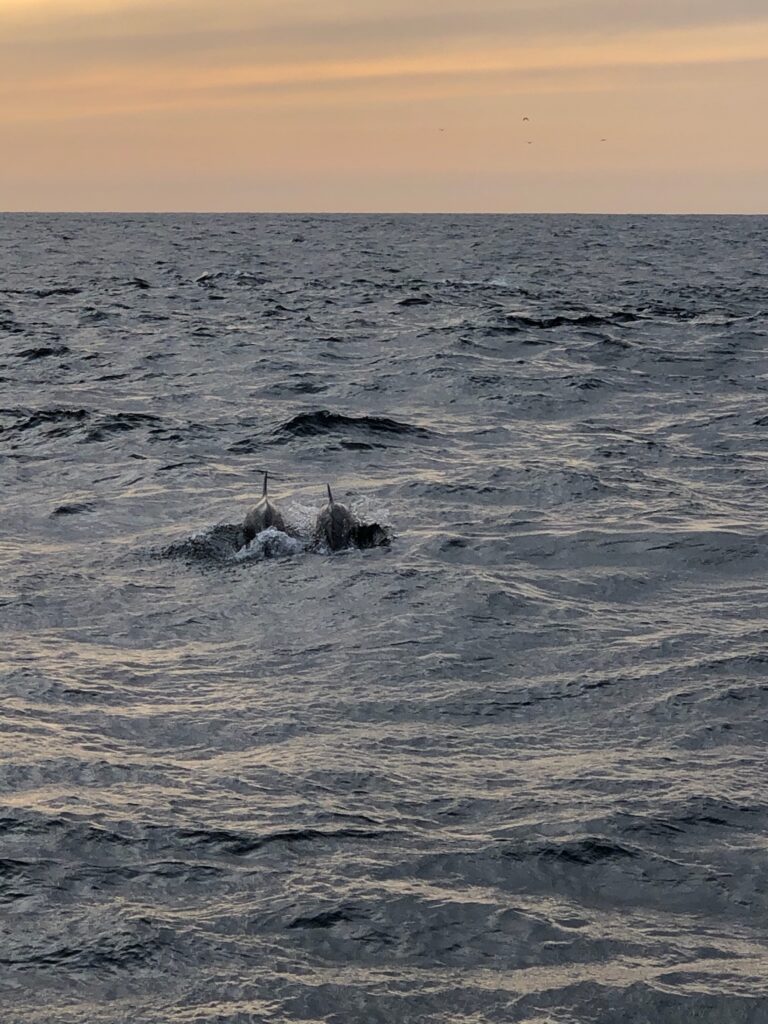
by Nicole Coffey, Ph.D. Student in Ocean, Earth, and Atmospheric Sciences
When I tell people that I study chemistry, often they imagine me standing over bubbling beakers in a lab. However, I study chemistry in the ocean, which means that my approaches need to break from that stereotype. What happens when the work you want to do can’t be done from a land-based lab? What if you have to go out to sea to do get the samples that you need?
Preparing to go to Sea
My advisor (Dr. Rene Boiteau), our collaborators at USC and UCLA, and I are interested in iron transport off the Oregon shelf. Iron is important in the oceans – it plays a role in chemical reactions in the water, and is required for key functions of marine organisms, such as photosynthesis. However, there is not a lot of iron available to critters in the ocean, since iron does not like to be dissolved in seawater and organisms cannot use iron unless it is dissolved. We wanted to investigate how iron moves throughout the ecosystem off the Oregon coast, and how organisms might be using the small amount of iron that is dissolved in the water. We can’t do this work from land – we needed water samples from offshore. So, we set sail on R/V Oceanus at the end of March on a scientific adventure!
Science can be tricky to do on land – and only gets more challenging when you go out to sea. For me, one of the most stressful parts of a research expedition is packing. On land, if you run out of supplies, you may be able to quickly borrow some from a neighboring lab, or buy more and have them delivered within a few days. At sea, if you run out of supplies you can’t get more. Your science has to stop. It’s very important that you pack everything you need (and not a bad idea to bring more than what you think you need, if you have the space to pack it). Packing for this trip involved a lot of spreadsheets and lists developed with my advisor, and triple-checking every box to make sure we had everything we would need out at sea.
We pack far in advance of a cruise to allow us time to figure out if we are missing any supplies. To be as safe as possible for this cruise, everyone going on the ship had to quarantine for two weeks, so we had to be ready to go even earlier. It was a lot of work, but everyone was prepared to board the ship and get set up to do some science at sea the day we reached R/V Oceanus!
Setting up Aboard R/V Oceanus and Science at Sea

Loading a ship with supplies for a successful cruise can be difficult. But we don’t have to carry every piece of equipment up the gangplank by hand. We use a crane to lift all of gear from the dock, assisted by the helpful ship’s crew. Once the gear was onboard, we spent the rest of the day organizing our spaces and setting up our equipment. Having our gear organized, and boxes labelled with their contents, helped this go smoothly! Out on the water, the ship rocks with the waves, meaning anything not held in place may slide around. To avoid an unsafe workspace, all of our gear had to be tied down or screwed into place. I secured the bottles and pump I would use to filter particles from my water samples to a benchtop with bungee cords and ratchet straps while other graduate students built a “bubble” of plastic sheeting to keep their workspace free from dust or potential contaminants. After a hard day’s work, we were all ready to leave port the next morning and get started collecting our samples.

Once we left port and arrived at our first sampling site, we used a piece of equipment called a CTD (which measures conductivity (to help determine salinity), temperature, and depth) to profile the water from the surface to near-bottom. We also measured how much oxygen was in the water. This information helped us to choose what depths we wanted to sample water from. As the CTD returned to the surface, we used a computer to tell bottles attached to the instrument to close, bringing us water from below the surface. Once the CTD was back on board, it was a flurry of action to collect our samples and get to work in the lab! First, we filter our samples to remove particles. Then, we use a technique called solid phase extraction (SPE) to remove salts and concentrate the sample. The samples are analyzed back on land.
In our downtime, we sometimes would go out on deck to take in the sight of water all around us. Sometimes, we had some visitors – over the course of the trip, we saw sea lions, albatross, gray whales, and dolphins! You never know what you’ll see when you’re out on the water (though fantastic sunsets are always a given).


After about a week on board, R/V Oceanus began to have some mechanical problems, and we were forced to return to port. It was disappointing to leave some objectives unfinished, but it was better to be safe rather than risk having worse problems down the line. Though our cruise was cut short, we collected some great samples during our time at sea. We’re all looking forward to analyzing the data to see what we might have found, and for our follow-up trip in July to learn more about iron dynamics on the Oregon shelf.
Follow Nicole on Twitter: @ChemNicoleOcean
See content from this cruise and our upcoming trip with this hashtag on Twitter: #FeTSh2021

